
Calibrachoa is a genus that added a completely new flavour to flowering horticulture products. Calibrachoa has its own character to stand alone and show off the whole season long, or you can mix two or three colours of calibrachoa to have eye-catching large containers, hanging baskets or pots.
Calibrachoa is a genus that added a completely new flavour to flowering
horticulture products. Calibrachoa has its own character to stand alone
and show off the whole season long, or you can mix two or three colours
of calibrachoa to have eye-catching large containers, hanging baskets
or pots.
Calibrachoa can be used with many other genera because it will blend
and not overtake the mixed container. It offers the best genetics to
come into the industry since impatiens were introduced in the early
1980s.
Calibrachoa, just as any other crop, has certain procedures to be
followed, including flower-inducing requirements, production steps,
variety selection, potential problems of varieties, scheduling and
marketing. I like to call all these ingredients The Cookbook.
Many of the early calibrachoa varieties required long days to flower
but most, if not all, of the new varieties are day-neutral. Saying
this, I hasten to add that light interruption or extending daylength
will speed up flowering.
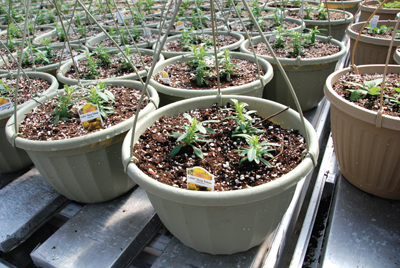 |
|
| Healthy calibrachoa liners, recently planted. (Photos Courtesy Melhem Sawaya) |
|
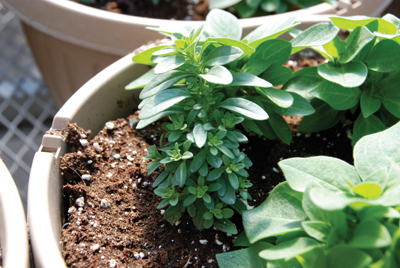 |
|
| Calibrachoa works well in combinations, never overpowering its neighbours. |
|
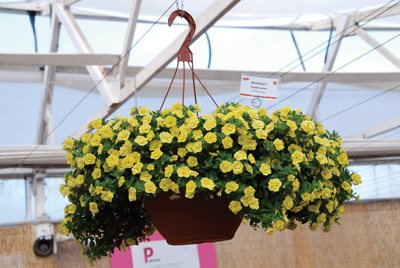 |
|
| Double calibrachoa flowers are especially eye-catching in any presentation. |
|
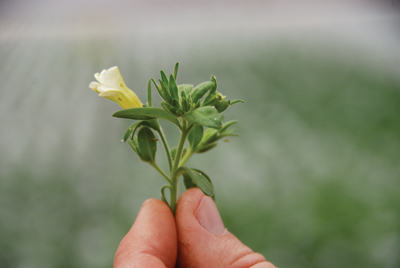 |
|
| Among other pests, aphids can be a problem. |
|
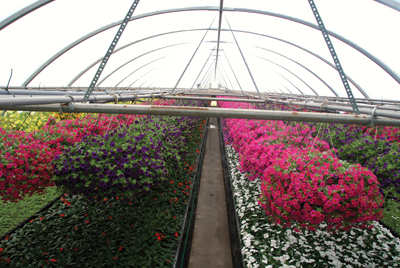 |
|
| Calibrachoa works perfectly in hanging baskets, either by itself or in combinations. |
|
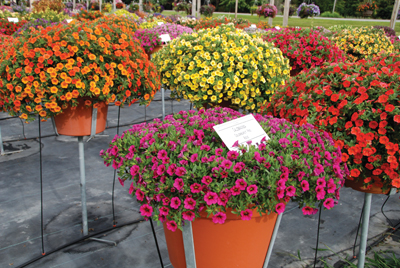 |
|
| Compact calibrachoa containers. |
|
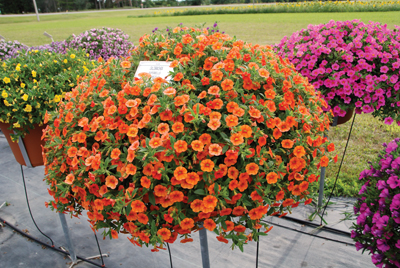 |
|
| If you’re looking for a good mounding performer, calibrachoa can fit the bill. |
|
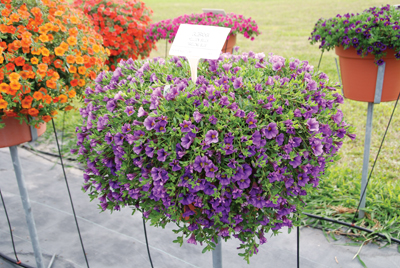 |
|
| A good example of a trailing calibrachoa container |
CULTURE REQUIREMENTS HIGHT LIGHT, COOL TEMPERATURES
Light: Calibrachoa loves high light levels with moderately cool
temperatures. Combined, these conditions will produce top quality
plants. Very few old genetics that are still in production need long
days to flower. Normally, these varieties are vigorous growers. If you
like to keep growing these varieties, night interruption can be used by lighting from 10 p.m. to 2 a.m. Or, better
yet, delay the planting date; this variety is especially vigorous, so
size will be achieved in a shorter time. And by planting later in the
season, you are closer to having natural long days.
Calibrachoa can be grown in lower light levels, but the quality is often poor and use of growth regulators is a must.
Temperature: If you are rooting your own cuttings, temperatures of 22ºC
minimum are a must, and 23ºC to 24ºC is preferable. With these
temperatures, 100 per cent humidity levels are a must, with a media not
oversaturated with water.
For growing on after planting, temperatures of 20ºC at night for two to
three weeks is important and a day temperature of 18ºC is required.
When the size of the plants is meant to cover the edge of the pots,
then temperatures of 13ºC to 14ºC both day and night are preferable.
If the crop is ready ahead of shipping dates, or needs to be held for
other reasons, calibrachoa can be held at temperatures of 10ºC day and
night. Just remember to increase the fertilizer rate. Plants at these
temperatures will not dry fast; watering, therefore, could be required
only every four to five days, and if fertilizer rates are not
increased, calibrachoa will be chloratic.
Nutrition: Fertilize at planting time with 100 ppm 20-8-20 or, better
yet, 18-9-18 (which is acidic), but don’t overwater. When roots of
liners are into the media, which should be in three to four days,
increase to 150-200 ppm. Every time that watering is required, add
18-9-18 fertilizer as long as you can see new growth and it is slightly
lighter green in colour.
A soil test is a must for any crop and especially for calibrachoa. A
low nutrition program will produce yellow plants. The E.C. target of
2:1 water:soil ratio is 1. For a saturated post-test, which labs
normally do, the target E.C. is 1.9-2.0.
The media pH target is 5.7-5.8. Continuous fertilization of calibrachoa with E.C. and pH monitoring is a must.
Yellow tip colouring or whole plant yellowing is due to lack of
nutrition, overwatering, or both. It is a fallacy that iron deficiency
is the main cause for calibrachoa yellowing. Though supplementing your
fertilizer program with EDDHA iron chelate will green the plants, the
point is to avoid the cause of yellowing so that we don’t need a
correction.
The use of 18-9-18 on calibrachoa and petunia proved to be a good
continuous diet because it is acidic fertilizer with extra iron. If you
decide to use 18-9-18 on calibrachoa, petunia and many of the low pH
crops, remember to avoid using it on zonal and seed geranium and
marigold, or any plant that prefers higher pH levels, and where high
levels of iron are toxic.
If you are adding a high rate of iron chelate, make sure you rinse the foliage. If subirrigation is used, no rinse is needed.
Watering: Calibrachoa doesn’t do well with long periods of wet feet.
Light watering at planting is a must. Increase water volume according
to the increase in plant size.
PRODUCTION SUGGESTIONS
Propagation: For propagation areas, a lower light is recommended,
especially in the first six to seven days, because it is then easier to
keep higher humidity without swamping the media. Light medium will help
drain excess water and allows for improved availability of oxygen to
the cutting.
Do not over-mist and cut the mist as soon as the first root signs
appear. Fertilize with 50-100 ppm at the first signs of roots. This
does not mean with a continuous fertilization through the mist line.
Just fertilize when you can leave the mist off overnight.
Medium: Peat Light medium is a must for propagation and growing on.
Starting with a media of 5.3 rather than 5.8 will help in keeping
calibrachoa on the green side, because the plants will take off faster
and be more active and the swamp culture is avoided.
Planting: Fertilize rooted cuttings before planting. That will help the
rooted liner get established with new roots in the lower E.C. of the
new media.
Plant only active rooted cuttings with active tips, no yellow ones.
Water lightly the first few times. Make sure the temperature is 20-21ºC
for the first two weeks.
Pinching: Pinching calibrachoa once will enhance the look of the
finished product. Either pinch the liner and wait for the new growth
before planting the liner, or plant the unpinched hanging baskets, wait
until they are rooted, and then pinch.
Calibrachoa branches freely but Ethrel (Florel), where registered, will enhance branching.
If liners are sheared once or twice before planting, then there is no need for the pinch.
If the crop is planted too early, then an Ethrel treatment is
beneficial because it will delay flowering and enhance the look of the
finished product.
Spacing: Calibrachoa, like any other plant, needs space. If you decide
that space is limited, then grow the size that fits the space. This
means fewer cuttings per container and more use of growth regulators
and you’ll end up with economy-size plants. Provide the space that your
market requires from you.
Growth Regulators: To shape the plants, give 2500 ppm B-Nine spray once
or twice. Use 5000 ppm B-Nine to hold the plants but 4 ppm Bonzi
sprench is much more effective and has longer-lasting effect. Using 240
ppm Ethrel (Florel), where registered, early on will reduce the
requirement of other growth regulators.
Also, other growth regulators can be used when:
| • | DIF of warm nights, cool days. |
| • | Watering as a growth regulator, too – the dryer the program, the shorter the plant. |
| • |
Fertilizer can also be used. The higher the rates, the more compact the plants, as long as we don’t increase fertilizer to the point of damaging the roots. |
| • | High light intensity is the best growth regulator. |
| • | The best finished product is the crop that is grown with high light and cool temperatures. |
MOULDING, TRAILING, COMPACT AND DOUBLE FLOWER VARIETIES
Calibrachoa has four major growing classes.
Mounding – where it grows to cover the pot with a mounding habit and then covering the top.
Trailing – where the branches trail down the pot without mounding.
Compact – where the plants are very slow in growing but cover the pots
nicely and are excellent if planted in pans or small pot sizes.
Double flowers – plant varieties are improving every year and give a higher-end product.
It is important to know the types or habits of the varieties, especially in combinations of different colours.
A trade name series does not mean the same growing habit but is simply a collection of all the colours.
PROBLEMS TO AVOID
Insects: Calibrachoa and aphids are always in the same story so
preventive treatment is a must. Biological controls are working very
well as long as they are followed properly. Thrips and spider mites
could also be problems.
Physiological: Overwatering is the main practice that leads to tip or all-over yellowing.
Scheduling: Unrooted cutting to rooted cutting should take 20 to 25 days.
| • | One rooted cutting to 4" = five weeks. |
| • | One rooted cutting to 6" = eight weeks. |
| • | Three to four rooted cuttings to 10" = eight to nine weeks. |
| • | Four to five rooted cuttings to 12" = nine weeks. |
Some varieties are more vigorous, so use the lower number of cuttings per container.
MARKET IMPORTANCE REFLECTED IN SALES
Of all genera, calibrachoa has seen the greatest increase in
production over the past three years. The excellent new breeding of
different cultivars is giving it the edge to fit in many different
applications.
Calibrachoa has unsurpassed beauty the whole summer long. Take
advantage of the demand for it as a stand-alone, in hanging baskets,
containers, or mixed containers.
Melhem Sawaya of Focus Greenhouse Management is a consultant and
research coordinator to the horticultural industry. Comments on this or
any other article are always welcome; please e-mail
mel@focusgreenhousemanagement.com, or visit
www.focusgreenhousemanagement.com or www.sawayagardentrials.ca.
Print this page